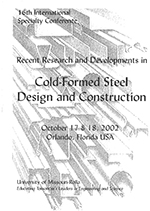Session Dates
17 Oct 2002
Abstract
The strength of sheathed wall systems is substantially greater than unsheathed walls with the same studs. Testing on studs sheathed on both sides with dry gypsum board demonstrate strength increases as large as 70% over unsheathed studs (Miller and Pekoz 1993, Miller and Pekoz 1994). The current AISI Specification for sheathed wall stud systems are complicated, only apply when the sheathing is identical on both sides, have several onerous prescriptive requirements, and the mechanical model employed has been questioned when compared to experimental results. This paper summarizes the deficiencies of, and arguments against, current models and suggests avenues of research for improvements. Analysis discussed herein, directed at answering the many open questions, leads to numerous interesting conclusions about the behavior of sheathed wall systems. Sheathing diaphragm stiffness should not yet be abandoned as the basic mechanical model. Diaphragm stiffness, per stud, is non-uniform and is not solely derived from stud spacing as assumed in AISI (1986) nor is it solely independent of stud spacing as assumed in AISI (1996, 2001). Shear stiffness, either locally of the material, or globally for the diaphragm, is the fundamental manner in which the sheathing resists weak axis buckling of the stud. For sheathing on one-side only, or highly dissimilar sheathing, cross-section distortion plays a role in the behavior and none of the existing (AISI) or proposed (Lee and Miller 2001) models account for this. Finally, freely available numerical tools provide a means to assess elastic buckling capacity of sheathed studs even with one-sided or dissimilar sheathing.
Department(s)
Civil, Architectural and Environmental Engineering
Research Center/Lab(s)
Wei-Wen Yu Center for Cold-Formed Steel Structures
Meeting Name
16th International Specialty Conference on Cold-Formed Steel Structures
Publisher
University of Missouri--Rolla
Document Version
Final Version
Rights
© 2002 University of Missouri--Rolla, All rights reserved.
Document Type
Article - Conference proceedings
File Type
text
Language
English
Recommended Citation
Schafer, Benjamin W. and Hiriyur, Badri, "Analysis of Sheathed Cold-formed Steel Wall Studs" (2002). CCFSS Proceedings of International Specialty Conference on Cold-Formed Steel Structures (1971 - 2018). 3.
https://scholarsmine.mst.edu/isccss/16iccfss/16iccfss-session7/3
Analysis of Sheathed Cold-formed Steel Wall Studs
The strength of sheathed wall systems is substantially greater than unsheathed walls with the same studs. Testing on studs sheathed on both sides with dry gypsum board demonstrate strength increases as large as 70% over unsheathed studs (Miller and Pekoz 1993, Miller and Pekoz 1994). The current AISI Specification for sheathed wall stud systems are complicated, only apply when the sheathing is identical on both sides, have several onerous prescriptive requirements, and the mechanical model employed has been questioned when compared to experimental results. This paper summarizes the deficiencies of, and arguments against, current models and suggests avenues of research for improvements. Analysis discussed herein, directed at answering the many open questions, leads to numerous interesting conclusions about the behavior of sheathed wall systems. Sheathing diaphragm stiffness should not yet be abandoned as the basic mechanical model. Diaphragm stiffness, per stud, is non-uniform and is not solely derived from stud spacing as assumed in AISI (1986) nor is it solely independent of stud spacing as assumed in AISI (1996, 2001). Shear stiffness, either locally of the material, or globally for the diaphragm, is the fundamental manner in which the sheathing resists weak axis buckling of the stud. For sheathing on one-side only, or highly dissimilar sheathing, cross-section distortion plays a role in the behavior and none of the existing (AISI) or proposed (Lee and Miller 2001) models account for this. Finally, freely available numerical tools provide a means to assess elastic buckling capacity of sheathed studs even with one-sided or dissimilar sheathing.



